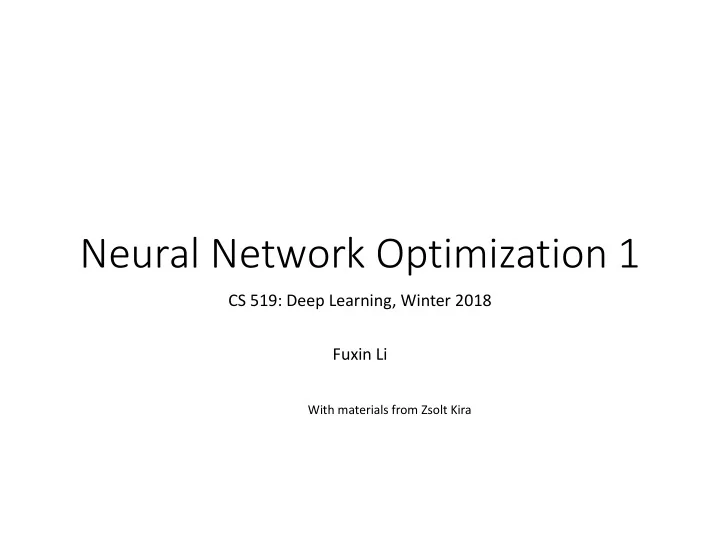

Neural Network Optimization 1 CS 519: Deep Learning, Winter 2018 Fuxin Li With materials from Zsolt Kira
Backpropagation learning of a network • The algorithm • 1. Compute a forward pass on the compute graph (DAG) from the input to all the outputs • 2. Backpropagate all the outputs back all the way to the input and collect all gradients • 3. for all the weights in all layers
Modules (Layers) • Each layer can be seen as a module • Given input, return • Output � �� • Network gradient � �� �� • Gradient of module parameters � �� � • During backprop, propagate/update • Backpropagated gradient 𝜖𝐹 𝜖𝑔 � �� �� �� �� ��� �𝑿 � = ��� ��� �� � �� ��� �� � � where � ��� � �
The abundance of online layers
Learning Rates • Gradient descent is only guaranteed to converge with small enough learning rates • So that’s a sign you should decrease your learning rate if it explodes • Example: � • � � • Learning rate of • • •
Weight decay regularization • Instead of using a normal step, add a • This corresponds to: � 1 + 1 2 𝜇 𝐗 � min 𝑂 � 𝑚(𝑔 𝑦 � ; 𝐗 , 𝑧 � ) 𝐗 ��� • Early stopping as well! • Help generalization
Momentum • Basic updating equation (with momentum): � ��� � � ��� � ��� • , a lot of “inertia” in optimization • Check the previous example with a momentum of 0.5
Normalization color indicates training case w 1 w 2 • Each component to 0 mean, 1 standard deviation • For ease of L2 regularization + optimization convergence rates 101, 101 0.1, 10 101, 99 0.1, -10 1, 1 1, -1 1, 1 1, -1
Computing the energy function and gradient • Usual ERM energy function � min � 𝐹 𝑔 = � 𝑀(𝑔 𝑦 � ; 𝑋 , 𝑧 � ) ��� � 𝛼 � 𝐹 = � 𝜖𝑀(𝑔 𝑦 � ; 𝑋 , 𝑧 � ) 𝜖𝑋 ��� • One problem: • Very slow to compute when is large • One gradient step takes long time! • Approximate?
Stochastic Mini-batch Approximation � min � 𝐹 𝑔 = � 𝑀(𝑔 𝑦 � ; 𝑋 , 𝑧 � ) ��� � 𝛼 � 𝐹 = � 𝜖𝑀(𝑔 𝑦 � ; 𝑋 , 𝑧 � ) 𝜖𝑋 ��� � ≈ � 𝜖𝑀(𝑔 𝑦 � ; 𝑋 , 𝑧 � ) 𝛼 � 𝐹 � 𝜖𝑋 �∈� � • Ensure the expectation is the same � = 𝛼 � 𝐹 𝔽 𝛼 � 𝐹 • Uniformly sample every time • Sample how many? 1 (SGD) – 256 (Mini-batch SGD) • Common mini-batch size is 32-256 • In practice: dependent on GPU memory size
In Practice • Randomly re-arrange the input examples • Use a fixed order on the input examples • Define an iteration to be every time the gradient is computed • An epoch to be every time that all the input examples is looped through once Iteration Iteration Iteration Data Epoch
A practical run of training a neural network • Check: • Energy • Training error • Validation error
Data Augmentation • Create artificial data to increase the size of the dataset • Example: Elastic deformations on MNIST
Data Augmentation Horizontal Flip 224x224 224x224 224x224 224x224 256x256 224x224 224x224 Training Image
Data Augmentation Horizontal Flip • One of the easiest ways to prevent overfitting is to augment the dataset 224x224 224x224 224x224 224x224 256x256 224x224 224x224 Training Image
CIFAR-10 dataset • 60,000 images in 10 classes • 50,000 training • 10,000 test • Designed to mimic MNIST • 32x32 • Assignment (will post on Canvas with more explicity): • Write your own backpropagation NN to test on CIFAR-10
Recommend
More recommend